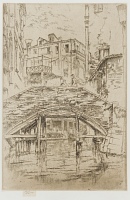Etchings Institutions search term: grolier club
Ponte del Piovan | ||
| Number: | 220 | |
| Date: | 1879/1880 | |
| Medium: | etching and drypoint | |
| Size: | 229 x 154 mm | |
| Signed: | butterfly at right | |
| Inscribed: | no | |
| Set/Publication: | 'Second Venice Set', 1886 | |
| No. of States: | 6 | |
| Known impressions: | 40 | |
| Catalogues: | K.209; M.206; W.179 | |
| Impressions taken from this plate (40) | ||
TECHNIQUE
Whistler etched most details of the composition and then used drypoint to complete the plate, adding and altering figures, details on the buildings, and shading on the bridge and water.
PRINTING
The first state was printed in black ink on off-white Japanese laid paper ( ). A proof of the second state is similar, on light grey Asian laid paper (
). A proof of the second state is similar, on light grey Asian laid paper ( ). Whistler kept another bare proof of the second state, printed in black ink on ivory wove paper (
). Whistler kept another bare proof of the second state, printed in black ink on ivory wove paper ( ). A strong, bright, proof of the third state is also in black, on ivory laid paper trimmed to the platemark and signed with a butterfly and 'imp' on the tab (
). A strong, bright, proof of the third state is also in black, on ivory laid paper trimmed to the platemark and signed with a butterfly and 'imp' on the tab ( ).
).
 ). A proof of the second state is similar, on light grey Asian laid paper (
). A proof of the second state is similar, on light grey Asian laid paper ( ). Whistler kept another bare proof of the second state, printed in black ink on ivory wove paper (
). Whistler kept another bare proof of the second state, printed in black ink on ivory wove paper ( ). A strong, bright, proof of the third state is also in black, on ivory laid paper trimmed to the platemark and signed with a butterfly and 'imp' on the tab (
). A strong, bright, proof of the third state is also in black, on ivory laid paper trimmed to the platemark and signed with a butterfly and 'imp' on the tab ( ).
). By the fifth state Whistler was ready to sell the plate for publication; an impression was printed by Émile Frédéric Salmon (1840-1913) in black ink on pale buff, fine 'laid' Japan paper ( ). However Whistler was not satisfied, and modified the plate further before printing it himself.
). However Whistler was not satisfied, and modified the plate further before printing it himself.
 ). However Whistler was not satisfied, and modified the plate further before printing it himself.
). However Whistler was not satisfied, and modified the plate further before printing it himself.
Ponte del Piovan was published by Messrs Dowdeswell and Thibaudeau with the Twenty-six Etchings or the 'Second Venice Set' in 1886. The record of impressions for this edition lists two delivered on 28 July, one on 20 August, seven on 6 October, twenty-one on 21 October and thirteen on 26 October 1886, a total of 44. 9
9: Whistler to W. Dowdeswell, GUW #08717.
The final, sixth, state would have been printed in October 1886. Whistler again kept a proof, printed in dark brown ink on off-white laid paper with a crowned hunting horn watermark ( ). Other impressions of the final state were printed both in brown and black ink; for instance, black on buff Asian laid paper, with light tone over the reflection of the bridge (
). Other impressions of the final state were printed both in brown and black ink; for instance, black on buff Asian laid paper, with light tone over the reflection of the bridge ( ), and on buff wove paper (
), and on buff wove paper ( ); brown ink on a 'modern' (post-1800) laid (
); brown ink on a 'modern' (post-1800) laid ( ) and dark brown on cream laid paper (
) and dark brown on cream laid paper ( ).
).
 ). Other impressions of the final state were printed both in brown and black ink; for instance, black on buff Asian laid paper, with light tone over the reflection of the bridge (
). Other impressions of the final state were printed both in brown and black ink; for instance, black on buff Asian laid paper, with light tone over the reflection of the bridge ( ), and on buff wove paper (
), and on buff wove paper ( ); brown ink on a 'modern' (post-1800) laid (
); brown ink on a 'modern' (post-1800) laid ( ) and dark brown on cream laid paper (
) and dark brown on cream laid paper ( ).
).
